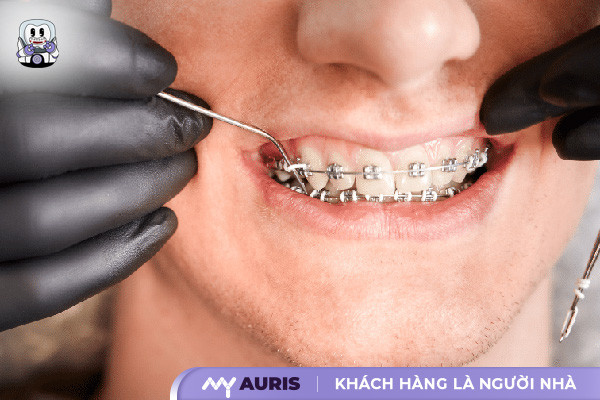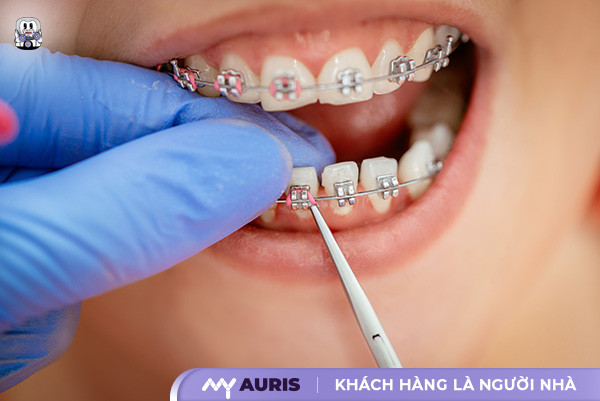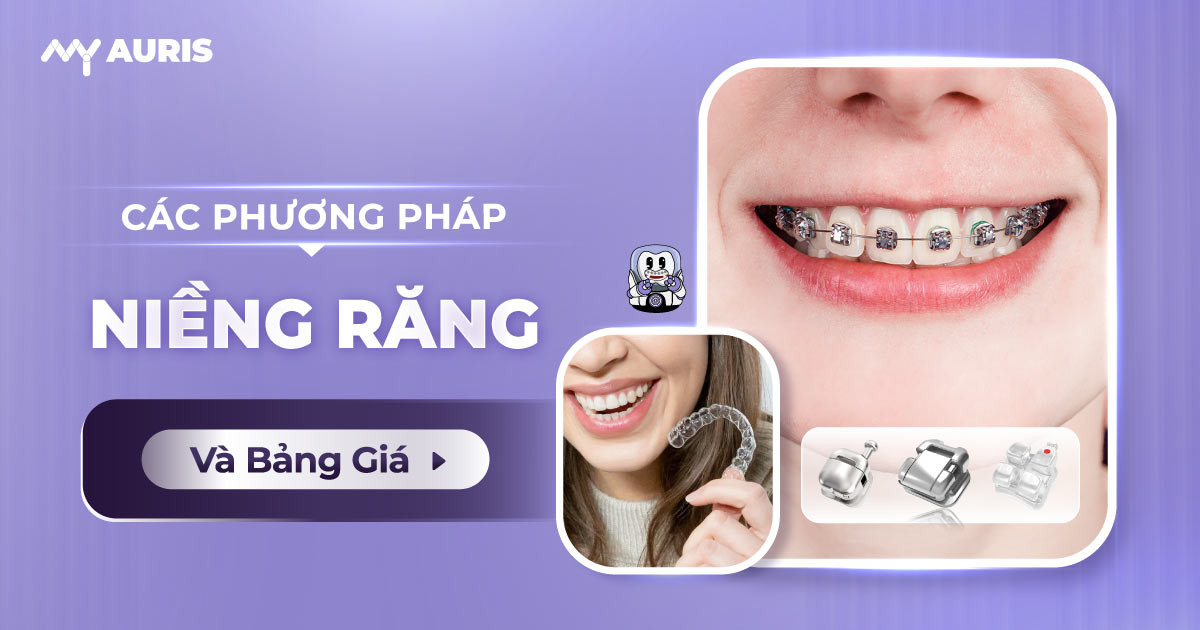If you want to have regular, naturally beautiful teeth and achieve an ideal bite, then braces are the safest and most effective choice today. In order to meet the increasing demand for aesthetics, safety and treatment effectiveness, modern dentistry has developed many advanced braces methods, suitable for each different oral condition.
What are braces?
Braces is a modern cosmetic dentistry method, using a system of wires, brackets, transparent braces and specialized tools to straighten teeth and move teeth to the correct position on the jaw. This is an effective solution to help improve the conditions of buck teeth, gap teeth, underbite teeth, crooked teeth, and malocclusion, bringing beautiful teeth and a radiant, confident smile.
In the past, metal braces were a popular choice in orthodontic treatment. However, due to aesthetics and inconvenience in daily life, this method is becoming less and less popular. The modern dental industry has constantly innovated, creating many advanced braces methods such as transparent braces, helping users easily choose the option that suits their personal needs. Thanks to that, today’s customers have a variety of choices, while enjoying a more comfortable and effective braces experience than ever before.

4 popular cosmetic braces methods today
In the field of orthodontics, there are currently 4 popular aesthetic braces methods including: metal braces types, ceramic braces, lingual braces and Invisalign braces. Each method possesses its own characteristics, along with different advantages and disadvantages. Choosing the appropriate option will depend on the current dental condition as well as each person’s specific braces requirements. Understanding each method will help you make the correct decision, suitable to your needs and ensure optimal aesthetic results.

Metal braces
Metal braces is a dental method that uses a system of metal brackets combined with an archwire to create tightening force, thereby moving teeth to the desired position on the jaw. This is a popular orthodontic technique, suitable for many different subjects and tooth conditions.
This method is divided into two main types:
Metal braces tied with elastic
Features: Use elastic elastic to fix the wire into the bracket groove, helping to maintain a stable tightening force throughout the treatment process.
Advantages:
- Highly effective in straightening teeth
- Reasonable cost, suitable for many audiences
- Shorter treatment time compared to other methods
- Does not require too much assistive technology
- Suitable for a variety of dental conditions
Disadvantages:
- Low aesthetics due to easily visible braces
- Can cause discomfort, easily rubs against lips and cheeks
- Adjustments take longer

Self-ligating metal braces (smart)
Features: Improved from Elastic tie type, self-ligating metal braces use a sliding system instead of elastic, helping to keep the archwire in place effectively without needing to change the wire frequently.
Advantages:
- Shorten treatment time
- Reduce the number of re-examination visits thanks to the ability to automatically hold the wire
- Tightening force is adjusted more flexibly, reducing sensitivity
- Less chance of wire slipping or deformation
- Low friction, helps limit gum pain
Disadvantages:
- Braces are large in size, which can cause discomfort when eating and drinking

Brackets Porcelain
Ceramic braces are an orthodontic method that operates on the same principle as metal braces, however the highlight lies in the high-quality ceramic material and the color is similar to the color of real teeth. Thanks to that, the braces are almost “invisible” on the jaw, helping people with braces maintain confidence when communicating, especially suitable for those who value it. aesthetics.
Currently, there are two popular types of ceramic braces:
Regular ceramic braces: Use a bracket system combined with an arch wire and elastic braces to pull teeth into the correct position. Method This ensures stable, continuous traction, making the orthodontic process more effective.
Self-locking ceramic braces: Have a similar design to self-closing metal braces, but the braces are made of ceramic material with an integrated automatic sliding cover or self-closing latch. This completely replaces the elastic band, helping to reduce the feeling of sensitivity in the early and evening stages Optimizing the experience for people with braces.
Compared to metal braces, ceramic braces possess many outstanding aesthetic advantages, while ensuring safety thanks to the benign nature of the ceramic material. However, the disadvantage is that the braces are thicker, causing a feeling of entanglement, and are prone to cracking when there is a strong impact With ceramic braces, you need to pay attention to careful hygiene to avoid colored foods from discoloring the braces.

Inner braces (lingual braces) tongue)
lingual braces, also known as lingual braces, are advanced orthodontic technology with the same principle as metal braces. However, the difference is that the brackets and wires are attached to the inside of the teeth, instead of the outside. Thanks to that, people with braces can rest assured because they are almost unrecognizable when communicating every day. This method is especially suitable for people who place a lot of emphasis on aesthetic factors such as MCs, actors, models – professions that require important appearance and frequent communication.
Outstanding advantages
- Absolute aesthetics: braces are hidden inside, giving you confidence without being recognized during the orthodontic process.
- The ideal solution for those who need to maintain a professional image at work.
Disadvantages to note
- Not suitable for cases of teeth with complex pathology or serious deviations.
- Treatment time may be longer than with external braces or clear braces.
- More difficult to clean, requiring users to take careful oral care.
- Requires a highly skilled and experienced doctor in treatment with lingual braces.

Clear braces
Currently, braces-free orthodontics includes three main methods: Invisalign braces, Ecligner braces and 3D Clear braces. The common point of these techniques is the use of transparent braces made from transparent material, helping to straighten teeth without the need for traditional braces. The difference lies in the origin, mechanism of action, and effectivenessSpecific treatment for each type.
Invisalign braces
Invisalign braces are an advanced orthodontic solution from the US, developed by Align Technology Dental Medical Equipment Group. With a smart mechanism based on the force-generating tab built into the braces tray, this method helps bring teeth to the correct position on the jaw accurately.
Normally, the Invisalign braces process requires 20 – 40 clear braces, depending on the degree of misalignment of the teeth. This method brings outstanding treatment results, effectively overcoming the conditions of overbite, underbite, underbite, and misalignment. However, if the cause of overbite or underbite comes from the jawbone, Invisalign treatment should be combined with jaw structure surgery to achieve optimal results.
Ecligner braces
Developed by Ecligner International Co., Ltd (Korea) specializing in the design Dental medical equipment, Ecligner braces is a technology certified by the Korean government and many international medical organizations.
Unlike Invisalign, Ecligner does not use force-generating tabs, but still ensures precise force to improve aesthetic teeth conditions such as overbites, underbites, gaps, and misalignments. During the course of treatment, patients will need to change 20 – 40 trays, depending on the condition of their teeth. The cost of performing Ecligner braces is lower than Invisalign, but the treatment effectiveness may be less in some complicated cases.
3D Clear braces
As an option in the group of braces-free orthodontics, 3D Clear braces combines elements of both Invisalign and Ecligner. The biggest advantage is the reasonable cost, making it more accessible for users, while still ensuring aesthetics and confidence in communication during the braces process.
Different from the above two methods, 3D Clear braces are crafted manually based on a 3D scan of tooth impressions, then pressed into a transparent plastic jaw model. This method is suitable for mild cases, such as teeth that are slightly misaligned, slightly overbite, slightly underbite, and slightly sparse. However, the effectiveness is not complete if applied to severe conditions, and the time to wear braces is often longer than with Invisalign or Ecligner. For cases of protrusion/underbite due to the jaw, treatment should be combined with braces or jaw surgery to achieve fast and sustainable results.

How much do braces cost?
The cost of braces is not fixed, but will vary depending on the type of braces you choosechoice as well as each person’s specific dental condition. To know the exact price of braces you need to prepare, you should visit directly with an orthodontist for thorough consultation and a suitable treatment regimen.
Below is the price list of braces at My Auris Dental for your reference. The price list includes both the listed price and current incentives – when getting braces, you will enjoy the most preferential promotional price today.
My Auris Dental braces price list – 2023
| Braces type | Level level | List price |
| Standard metal braces | Level 1 | 25,000,000 |
| Level 2 | 30,000,000 | |
| Level 3 | 35,000,000 | |
| Self-locking metal braces | Level 1 | 35,000,000 |
| Level 2 | 40,000,000 | |
| Level 3 | 45,000,000 | |
| Standard ceramic braces | Level 1 | 30,000,000 |
| Level 2 | 35,000,000 | |
| Level 3 | 40,000,000 | |
| Self-locking ceramic braces | Level 1 | 50,000,000 |
| Level 2 | 55,000,000 | |
| Level 3 | 60,000,000 |





